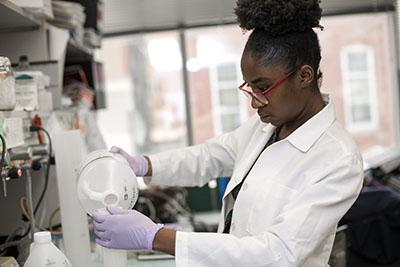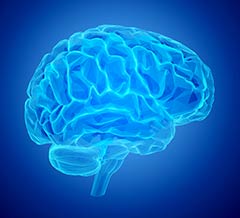Cluster Areas
Cluster Areas

UM FIRST recruits will be hired in three broad research areas in which the University of Maryland has great strength, cancer biology, neuroscience, and microbiology/immunology/infectious diseases. Together, these research areas account for more than $400M in research funding at UMSOM, so FIRST recruits in these areas will have a rich research environment with numerous opportunities for collaboration and interactions.
Cancer Biology
The focus of cancer research at UMSOM is in the University of Maryland Greenebaum Comprehensive Cancer Center (UMGCCC). One of only 53 NCI-designated Comprehensive Cancer Centers in the country, UMGCCC’s mission is to undertake innovative basic, clinical, and population research that will impact the understanding and treatment of cancer around the world and to provide state-of-the-art clinical care to cancer patients in Maryland and beyond.
UMGCCC also leads cancer education and training through the University of Maryland and leads UMSOM efforts in developing diversity STEM pipeline programs for URM students of all ages, including multiple NIH-funded programs. UMGCCC’s research and clinical programs are organized into five main areas:
- Molecular and Structural Biology, in which program members study mechanistic cancer-relevant questions at the cellular and molecular level;
- Hormone Related Cancers, with basic, translational, and clinical research for cancers that arise from hormone-related tissues;
- Tumor Immunology and Immunotherapy, whose members conduct basic science, translational, and clinical trials to develop and implement immune-based strategies to monitor and treat cancer;
- Experimental Therapeutics Program, whose members develop and test new therapies for solid tumors and hematologic malignancies based on innovative preclinical research
- Population Science, whose members identify determinants of cancer etiology, cancer-related behavior, and outcomes, and who seek to translate basic discoveries into behavioral interventions to prevent and control cancer.
Total cancer research funding at UMSOM is about $101M, with some $15M from the NCI.
UMBC has a robust cancer research community focused on basic and translational aspects of malignancy. Major areas of interest include rodent modeling of prostate, ovarian, and breast cancers with a view toward understanding fundamental molecular mechanisms of initiation, progression, and metastasis, as well as pre-clinical testing of new therapeutics. Basic mechanisms underpinning genetic and epigenetic changes associated with malignancy are areas of high interest. Core strengths include in vivo imaging using state-of-the-art luminescence and CT imaging modalities and transgenic mouse and rat production using conventional gain-of-function and targeted genome modification. UMBC is a member of the Translational and Basic Research in Early Lesions (TBEL) Initiative consortium (U54) funded by the NIH Divisions of Cancer Prevention and Cancer Biology.
Neuroscience
UMSOM is a regional and national powerhouse in neuroscience research and clinical care, with expertise distributed widely across and within departments, programs, and centers. The focal point for neuroscience research is our newly founded University of Maryland – Medicine Institute for Neuroscience Discovery (UM-MIND) which will leverage the more than 120 leading neuroscientists on campus to accelerate translational research of the brain by facilitating the interaction between basic and clinical scientists and enhance collaborative research across the UMB campus. UM-MIND focuses on three pillars of strength: 1) neurodevelopment and neuropsychiatric disorders, 2) neurotrauma and brain injury, and 3) aging and neurodegeneration.
UM-MIND faculty and neuroscience research involves faculty from seven UMSOM academic departments (Anatomy & Neurobiology, Physiology, Pharmacology, Neurology, Neurosurgery, Psychiatry, and Diagnostic Radiology & Nuclear Medicine) and multiple centers and institutes (Maryland Psychiatric Research Center, Center for Shock, Trauma, and Anesthesiology Research, and the Institute for Genome Sciences) have major research programs in neuroscience.
The Maryland Psychiatric Research Center (MPRC) is an internationally renowned clinical and basic science facility focusing on the origin and treatment of schizophrenia. Additional areas of expertise include addiction, traumatic brain injury, neurodegeneration, neuroimaging, neurodevelopment, and neurogenomics, amongst others.
UMSOM currently has more than $107 million in active funding for neuroscience research, of which $80 million comes from the NIH.
The neuroscience research conducted in the biological sciences department at UMBC has a strong emphasis on sensory biology with research programs aimed at investigating chemical sensory systems and visual systems in both mammals and invertebrates. There is also research designed to understand the molecular mechanisms of neurulation in zebrafish. Current UMBC faculty research interests range from molecular neurobiology and neural and behavioral systems to analysis and modeling of neurons. Research approaches include both the theoretical and the experimental.
In addition to the neuroscience research conducted on campus, UMBC faculty and students collaborate on research projects at UMSOM's Maryland Psychiatric Research Center (MPRC), which is in close physical proximity to UMBC.
Microbiology/Immunology/Infectious Disease

UMSOM has one of the largest and strongest academic communities for the study of infectious diseases, vaccinology, and microbiology & immunology. Research in these areas are housed in three internationally recognized research centers, The Center for Vaccine Development and Global Health (CVD), the Institute of Human Virology (IHV), and the Institute for Genome Sciences (IGS) and the academic Department of Microbiology & Immunology.
Founded in 1974, the CVD focuses on the development and testing of new vaccines for the prevention of bacterial, viral, and parasitic diseases. In addition to performing crucial basic science research in vaccine development, CVD has played a leading role in the testing of COVID-19 vaccines in the US, as well as numerous international field trials, including the Ebola Virus vaccine in Mali. IHV, established in 1996, focuses on the discovery of diagnostics, therapeutics, and vaccines for a variety of chronic and deadly viral diseases, most notably HIV. IHV has an extensive global network with an on-ground presence in 7 African and 2 Caribbean nations, overseeing HIV treatment for over 1 million individuals worldwide. IGS has pioneered genomic discoveries in the areas of genomic analysis of bacteria, viruses, parasites, and fungal pathogens.
It has led projects ranging from the investigation of anthrax attacks to the NIH Human Microbiome Project. The Department of Microbiology & Immunology has expertise in various areas, including SARS-CoV-2, tick-borne diseases, and innate immunity. It is currently ranked 5th in NIH funding among all US medical school departments. Taken together, the UMSOM received more than $200M in research funding in FY21, with $47 million coming from the NIH and the remainder coming from a variety of sources including the Bill & Melinda Gates Foundation, the WHO, other major foundations, and pharmaceutical companies. This includes three separate NIH-funded training grants specifically in immunology, microbiology, and vaccinology.
UMBC has long had a major effort in the biology of microorganisms and continues to have strength in classical microbiology as well as the molecular and cell biology, physiology and evolution of microbial species, both prokaryotic and eukaryotic. Our prokaryotic microbiology work focuses on the physiology of carbon and nitrogen metabolism and its regulation, copper tolerance in marine bacteria and biofilm formation. Our eukaryotic microbiology focuses on fundamental issues: cell division control, regulation of gene transcription and translational control in model eukaryotic microbes. These laboratory-based investigations are supplemented by strength in the bioinformatics of bacterial gene regulation including coordinate regulation of large networks of genes involved in stress response.

